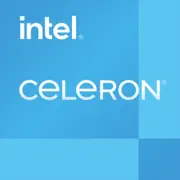Intel Celeron G6900

Intel Celeron G6900: processore economico per compiti di base nel 2025
Recensione attuale per chi cerca una soluzione accessibile ed energeticamente efficiente
1. Caratteristiche principali: Alder Lake in miniatura
Architettura e processo tecnologico
Il processore Intel Celeron G6900 appartiene alla generazione Alder Lake (12ª generazione Intel), lanciata alla fine del 2021, ma rimane attuale per assemblaggi economici nel 2025. È costruito su un'architettura ibrida, ma, a differenza dei modelli superiori (Core i5, i7), qui sono utilizzati solo 2 Performance-cores (P-cores) senza Efficient-cores (E-cores). Questo spiega la modesta prestazione in multi-threading.
Il processo tecnologico è Intel 7 (equivalente a 10 nm), il che assicura un buon equilibrio tra efficienza energetica e prestazioni. La frequenza base è 3.40 GHz, il overclock non è supportato. La dimensione della cache L3 è di 4 MB, che è sufficiente per compiti leggeri, ma non per calcoli complessi.
Prestazioni e grafica
Nel test Geekbench 6 (2025) il Celeron G6900 mostra i seguenti risultati:
- 1563 punti in modalità single-core;
- 2631 punti in multi-core.
Questi risultati sono paragonabili a quelli dell'Intel Core i3 di 10ª generazione, ma inferiori rispetto ai moderni budget AMD Ryzen 3. La grafica integrata Intel UHD Graphics 710 supporta una risoluzione fino a 4K (60 Hz) tramite HDMI 2.0 o DisplayPort 1.4, ma non è destinata ai giochi — solo per il lavoro di base con video e applicazioni per ufficio.
2. Schede madri compatibili: socket LGA 1700 e chipset
Socket e chipset
Il processore utilizza il socket LGA 1700, supportato dalle schede madri con chipset:
- H610 — scelta ottimale per il Celeron G6900 (prezzo $70–90);
- B660 — con funzionalità avanzate (PCIe 4.0, più porte USB, prezzo $100–130);
- H670/Z690 — eccessive per questo processore, ma adatte per futuri aggiornamenti.
Esempi di schede madri:
- ASUS Prime H610M-E D4 ($75) — versione base con DDR4;
- Gigabyte B660M DS3H DDR4 ($110) — supporto per PCIe 4.0 e M.2 NVMe.
Considerazioni sulla scelta
- DDR4 vs DDR5: Il Celeron G6900 supporta entrambi i tipi di memoria, ma le schede madri con H610 tendono a lavorare più spesso con DDR4, il che riduce il costo dell'assemblaggio.
- PCIe 5.0: Tecnologicamente, il processore supporta lo standard, ma non è critico per compiti economici.
3. Memoria: DDR4 vs DDR5
Il processore è compatibile con:
- DDR4-3200 (consigliata per risparmiare);
- DDR5-4800 (eccessivo per il Celeron, ma utile per futuri aggiornamenti).
Consiglio: Per l'assemblaggio con Celeron G6900, scegliete 8–16 GB di DDR4. Ad esempio, un kit Crucial DDR4-3200 16 GB costerà tra $30 e $40. DDR5 aumenterà il budget di $20–30 senza un aumento significativo delle prestazioni.
4. Alimentatore: minimalismo nel consumo energetico
Con un TDP di 46 W, il processore non richiede un alimentatore potente. Raccomandazioni:
- 300–400 W con certificazione 80+ Bronze (ad esempio, EVGA 400W — $40 o Corsair CX450 — $55);
- È importante considerare il consumo energetico degli altri componenti: SSD, scheda video (se utilizzata), ecc.
Importante: Per un assemblaggio con grafica integrata, basta un alimentatore da 300 W. Se è prevista una scheda video discreta (ad esempio, GTX 1650), optate per 450 W.
5. Pro e contro del Celeron G6900
Vantaggi:
- Prezzo: $50–60 (nuovo, 2025) — uno dei processori più accessibili;
- Efficienza energetica: ideale per PC compatti e sistemi da ufficio;
- Supporto per DDR5 e PCIe 5.0 (utile per l'aggiornamento);
- Grafica integrata — non è necessario acquistare una scheda video.
Svantaggi:
- 2 core/2 thread — multitasking debole;
- UHD 710 — non adatta per giochi e montaggio;
- Piccola cache L3 — rallenta nelle applicazioni “pesanti”.
6. Scenari d'uso: dove il Celeron G6900 è pertinente
- PC da ufficio: Lavoro con documenti, browser, Zoom.
- Media center domestico: Visione di video 4K tramite Plex o Kodi.
- Progetti educativi: PC per studenti/scolari.
- Giochi leggeri: Minecraft, Stardew Valley, giochi retro tramite emulatori.
Esempio: Un assemblaggio con Celeron G6900 + 8 GB di DDR4 + SSD 256 GB gestirà 10 schede di Chrome e video in streaming senza lag.
7. Confronto con i concorrenti
AMD Athlon 3150G (2024)
- Prezzo: $60;
- Caratteristiche: 4 core/4 thread, GPU Vega 3;
- Vantaggi: Migliore prestazione in multi-threading;
- Svantaggi: Socket AM4 obsoleto, TDP più elevato (65 W).
Intel Pentium Gold G7400
- Prezzo: $75;
- Caratteristiche: 2 core/4 thread, UHD 710;
- Vantaggi: Hyper-Threading per il multitasking;
- Svantaggi: Più costoso del Celeron con grafica simile.
Conclusione: Il Celeron G6900 vince per prezzo, ma perde in multi-threading.
8. Consigli pratici per l'assemblaggio
1. Scheda madre: Scegliete H610 con DDR4 (ASUS Prime H610M-K — $75).
2. Memoria: 8–16 GB di DDR4-3200.
3. Storage: NVMe SSD da 256 GB (ad esempio, Kingston NV2 — $30).
4. Case: Mini-tower compatto con ventilazione (Deepcool MATREXX 30 — $35).
5. Raffreddamento: Il cooler di serie è sufficiente — rumore minimo.
Esempio di budget:
- Processore: $55
- Scheda madre: $75
- RAM: $30
- SSD: $30
- Alimentatore: $40
- Case: $35
Totale: ~$245.
9. Conclusione finale: a chi è adatto il Celeron G6900?
Questo processore è la scelta ideale per:
- PC da ufficio: Prezzo e consumo energetico contenuti.
- Home theater: Video 4K senza intoppi.
- Sistemi di riserva: Ad esempio, server di file storage.
- Studenti: Per studio e compiti poco esigenti.
Perché evitarlo: Se servono giochi, montaggio video o lavoro in programmi “pesanti” (Photoshop, AutoCAD). Nel 2025, il Celeron G6900 rimane una soluzione di nicchia, ma per i suoi compiti è un'opzione vantaggiosa e affidabile.
Di base
Specifiche della CPU
Specifiche della memoria
Specifiche della GPU
Varie
Classifiche
Rispetto ad altre CPU
Condividi sui social media
Oppure linkaci
<a href="https://cputronic.com/it/cpu/intel-celeron-g6900" target="_blank">Intel Celeron G6900</a>